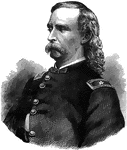Clipart tagged: ‘Rappahannock’
Commissariat Depot
"Commissariat Depot of the United States Army of the Rappahannock at Manassas, Va. Our sketch shows…

George Custer
"General George A. Custer, born in New Rumley, Harrison County, Ohio, December 5th, 1839, died in Montana,…

Army of the Potomac
"Army of the Potomac recrossing the Rappahannock from Fredericksburg to Falmouth, on the night of Monday,…
Rappahannock
"The city of Fredericksburg, VA., from the North side of the Rappahannock- from a sketch by our special…

Rappahannock Bridge
"Rebuilding of the railroad bridge over the Rappahannock to Fredericksburg, burnt by the Confederates…

Winter Quarters
"Winter quarters on the Rappahannock- army huts of the One Hundred and Nineteenth Regiment, Pennsylvania…